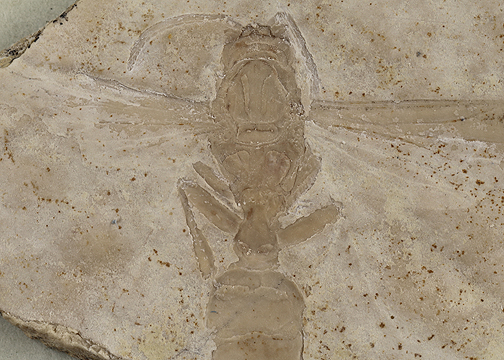Abstract
Polistine wasps (Vespidae: Polistinae) are iconic eusocial wasps found throughout the world, famed for their range of social organization and therefore a favorite subject for sociobiological studies (e.g., Gadagkar, 2001; Piekarski et al., 2018). The subfamily is currently organized into four tribes: the New World Epiponini and Mischocyttarini, the cosmopolitan Polistini, and the Afrotropical, Indomalayan, and Australian Ropalidiini.
References
- Antropov, A.V., Belokobylskij, S.A., Compton, S.G., Dlussky, G.M., Khalaim, A.I., Kolyada, V.A., Kozlov, M.A., Perfilieva, K.S. & Rasnitsyn, A.P. (2014). The wasps, bees and ants (Insecta: Vespida = Hymenoptera) from the Insect Limestone (Late Eocene) of the Isle of Wight, UK. Earth and Environmental Science Transactions of the Royal Society of Edinburgh, 104 (3–4), 335–446. https://doi.org/10.1017/S1755691014000103
- Bequaert, J.C. (1918) A revision of the Vespidae of the Belgian Congo based on the collection of the American Museum Congo Expedition, with a list of Ethiopian diplopterous wasps. Bulletin of the American Museum of Natural History, 39 (1), 1–384. http://hdl.handle.net/2246/995
- Carpenter, J.M. (1982) The phylogenetic relationships and natural classification of the Vespoidea. Systematic Entomology, 7 (1), 11–38. https://doi.org/10.1111/j.1365-3113.1982.tb00124.x
- Carpenter, J.M. & Grimaldi, D.A. (1997) Social wasps in amber. American Museum Novitates, 3203, 1–7. http://hdl.handle.net/2246/3605
- Carpenter, J.M. & Nguyen, L.T.P. (2003) Keys to the genera of social wasps of South-East Asia (Hymenoptera: Vespidae). Entomological Science, 6 (3), 183–192. https://doi.org/10.1046/j.1343-8786.2003.00016.x
- Cockerell, T.D.A. (1914) Miocene fossil insects. Proceedings of the Academy of Natural Sciences of Philadelphia, 66 (3), 634–648. https://www.jstor.org/stable/4063603
- Gadagkar, R. (2001) The Social biology of Ropalidia marginata: toward understanding the evolution of eusociality. Harvard University Press, Cambridge, 384 pp. https://doi.org/10.4159/9780674037458
- Gaudant, J., Nel, A., Nurt, D., Véran, M. & Carnevale, G. (2018) The uppermost Oligocene of Aix-en-Provence (Bouches-du-Rhône, southern France): a Cenozoic brackish subtropical Konservat-Lagerstätte, with fishes, insects and plants. Comptes Rendus Palevol, 17 (7), 460–478. https://doi.org/10.1016/j.crpv.2017.08.002
- Heer, O. (1865) Die Urwelt der Schweiz. F. Schulthess, Zürich, 622 pp.
- Latreille, P.A. (1802) Histoire naturelle, générale et particulière des Crustacés et des Insectes. Ouvrage faisant suite à l’histoire naturelle générale et particulière, composée par Leclerc de Buffon, et rédigée par C.S. Sonnini, membre de plusieurs sociétés savantes. Tome troisième. Dufart, Paris, xii+467 pp. https://doi.org/10.5962/bhl.title.15764
- Lepeletier de Saint Fargeau, A.L.M. (1836) Histoire naturelle des insectes–Hyménoptères. Tome Premier. Roret, Paris, 547 pp. https://doi.org/10.5962/t.173542
- Perrard, A., Nel, A. & Carpenter, J.M. (2014) A new paper wasp from Late Eocene of France (Hymenoptera: Vespidae: Polistinae). Zootaxa, 3753 (6), 542–548. https://doi.org/10.11646/zootaxa.3753.6.2
- Piekarski, P.K., Carpenter, J.M., Lemmon, A.R., Lemmon, E.M. & Sharanowski, B.J. (2018) Phylogenomic evidence overturns current conceptions of social evolution in wasps (Vespidae). Molecular Biology and Evolution, 35 (9), 2097–2109. https://doi.org/10.1093/molbev/msy124
- Piton, L. (1940) Paléontologie du gisement éocène de Menat (Puy-de-Dôme), flore et faune. Mémoire de la Société d’Histoire Naturelle d’Auvergne, 1, 1–303.
- Statz, G. (1936) Ueber alte und neue fossile Hymenopterenfunde aus der tertiären Ablagerungen von Rott am Siebengebirge. Decheniana, 93, 256–312.
- Théobald, N. (1937) Les insectes fossiles des terrains oligocènes de France. Mémoires de la Société des Sciences de Nancy, 2, 1–472.


